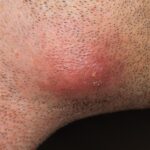Diverticulosis is a common condition characterized by the formation of small pouches, known as diverticula, in the wall of the colon. These pouches typically develop in weak spots and protrude outwards, most frequently in the sigmoid colon, which is the lower segment of your large intestine.
A single pouch is termed a diverticulum, while multiple pouches are called diverticula. It’s important to note that the majority of individuals with diverticulosis are asymptomatic and experience no complications. However, for some, these pouches can become problematic, leading to symptoms or inflammation.
Diverticulosis vs. Diverticulitis: Key Differences
It’s crucial to differentiate diverticulosis from diverticulitis. Diverticulitis occurs when these diverticula become inflamed or infected. This condition can manifest suddenly and may result in serious health issues and complications requiring medical attention. While diverticulosis is often a silent condition, diverticulitis is an active and potentially painful problem.
Diverticular Disease: A Broader Perspective
The term diverticular disease encompasses a range of conditions related to diverticula in the colon. Diverticular disease is diagnosed when diverticula cause:
- Chronic and persistent symptoms affecting daily life.
- Diverticular bleeding, which is the occurrence of bleeding from the pouches.
- Diverticulitis, including episodes of inflammation and associated complications.
Diverticular disease, therefore, represents a spectrum of problems that can arise from the presence of diverticula, ranging from bothersome symptoms to severe complications.
How Common is Diverticulosis? Prevalence and Statistics
Diverticulosis is remarkably common, and its prevalence increases significantly with age. Statistics indicate that over 30% of adults in the United States between 50 and 59 years old have diverticulosis. This figure rises dramatically to over 70% for those older than 80.
Despite its high prevalence, most people with diverticulosis remain unaware of their condition as they never develop symptoms or experience problems. Medical experts are still researching to determine the exact percentage of asymptomatic individuals who will eventually develop symptoms without progressing to diverticulitis.
Fortunately, diverticulitis is less common than diverticulosis. Less than 5% of individuals with diverticulosis will develop diverticulitis. In the U.S., approximately 200,000 people are hospitalized each year due to diverticulitis, and around 71,000 hospitalizations annually are attributed to diverticular bleeding.
Who is at Higher Risk? Factors Influencing Diverticular Disease
Age is a primary risk factor for both diverticulosis and diverticulitis. The likelihood of developing these conditions increases as people get older.
Interestingly, there are some gender and racial differences in the presentation of diverticular disease. In individuals under 50, diverticulitis is observed more frequently in men than in women. However, this trend reverses in people aged 50 and older, where diverticulitis becomes more prevalent in women.
Research also suggests racial disparities in diverticular disease within the United States. Diverticulitis is found to be more common among White Americans compared to other racial groups, while diverticular bleeding is more frequently observed in Black Americans. Further research is needed to fully understand these demographic differences.
Potential Complications of Diverticular Disease
For some individuals, diverticular disease can lead to serious complications. In certain cases, these complications might be the first indication that a person has diverticular disease.
Diverticular Bleeding: A Significant Concern
Diverticular bleeding occurs when a small blood vessel within a diverticulum pouch ruptures. This is a common cause of lower gastrointestinal bleeding. Diverticular bleeding can be severe, even life-threatening, requiring prompt medical intervention to manage blood loss.
Complications from Diverticulitis
Diverticulitis itself can lead to a range of complications. These can include abscess formation, fistulas, bowel obstruction, and perforation. These complications often require hospitalization and, in some cases, surgery.
Conclusion: Understanding Diverticulosis for Proactive Health
In summary, diverticulosis is a widespread condition characterized by the presence of pouches in the colon. While often asymptomatic, it’s important to understand its potential to develop into diverticulitis and other forms of diverticular disease. Awareness of diverticulosis, its prevalence, and potential complications is key for proactive health management, particularly as we age. If you experience persistent abdominal symptoms, it’s important to consult with a healthcare professional for proper diagnosis and guidance.

